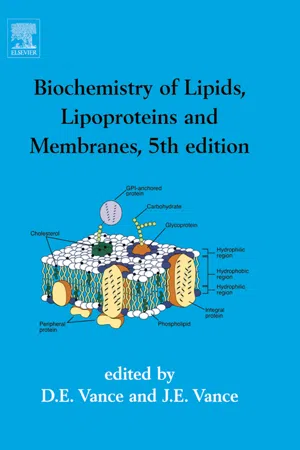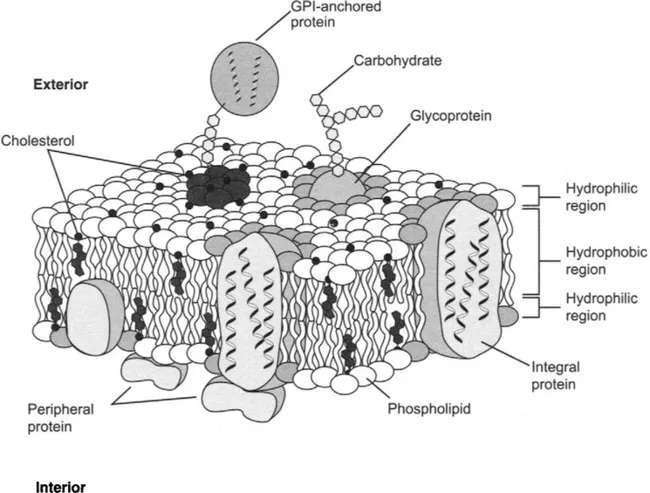
Biochemistry of Lipids, Lipoproteins and Membranes
- 624 pages
- English
- ePUB (mobile friendly)
- Available on iOS & Android
Biochemistry of Lipids, Lipoproteins and Membranes
About this book
Research on the biochemistry and molecular biology of lipids and lipoproteins has experienced remarkable growth in the past 20 years, particularly with the realization that many different classes of lipids play fundamental roles in diseases such as heart disease, obesity, diabetes, cancer and neurodegenerative disorders. The 5th edition of this book has been written with two major objectives. The first objective is to provide students and teachers with an advanced up-to-date textbook covering the major areas of current interest in the lipid field. The chapters are written for students and researchers familiar with the general concepts of lipid metabolism but who wish to expand their knowledge in this area. The second objective is to provide a text for scientists who are about to enter the field of lipids, lipoproteins and membranes and who wish to learn more about this area of research. All of the chapters have been extensively updated since the 4th edition appeared in 2002.- Represents a bridge between the superficial coverage of the lipid field found in basic biochemistry text books and the highly specialized material contained in scientific review articles and monographs- Allows scientists to become familiar with recent developments related to their own research interests, and will help clinical researchers and medical students keep abreast of developments in basic science that are important for subsequent clinical advances- Serves as a general reference book for scientists studying lipids, lipoproteins and membranes and as an advanced and up-to-date textbook for teachers and students who are familiar with the basic concepts of lipid biochemistry
Frequently asked questions
- Essential is ideal for learners and professionals who enjoy exploring a wide range of subjects. Access the Essential Library with 800,000+ trusted titles and best-sellers across business, personal growth, and the humanities. Includes unlimited reading time and Standard Read Aloud voice.
- Complete: Perfect for advanced learners and researchers needing full, unrestricted access. Unlock 1.4M+ books across hundreds of subjects, including academic and specialized titles. The Complete Plan also includes advanced features like Premium Read Aloud and Research Assistant.
Please note we cannot support devices running on iOS 13 and Android 7 or earlier. Learn more about using the app.
Information
Functional roles of lipids in membranes
Publisher Summary
1 Introduction and overview
| Lipid | Erythrocytea | CHO cellsb | Mitochondriac | Endoplasmic reticulumd | E. colie | |
| Outer | Inner | |||||
| Cholesterol | 25 | − | N.D. | N.D. | 20 | N.D. |
| PE | 18 | 21 | 33 | 24 | 21 | 75 |
| PC | 19 | 51 | 46 | 38 | 46 | N.D. |
| Sphingomyelin | 18 | 9 | − | − | 9 | N.D. |
| PS | 9 | 7 | 1 | 4 | 2 | <1 |
| PG | 0 | 1 | N.D. | N.D. | − | 20 |
| CL | 0 | 2.3 | 6 | 16 | − | 5 |
| PI | 1 | 8 | 10 | 16 | 2 | N.D. |
| Glycosphingolipid | 10 | − | − | − | − | N.D. |
| PA | − | 1 | 4 | 2 | − | <2 |

2 Diversity in lipid structure
2.1 Glycerolipids
Table of contents
- Cover image
- Title page
- Table of Contents
- Preface
- List of contributors
- Chapter 1: Functional roles of lipids in membranes
- Chapter 2: Lipid modifications of proteins
- Chapter 3: Fatty acid and phospholipid metabolism in prokaryotes
- Chapter 4: Lipid metabolism in plants
- Chapter 5: Oxidation of fatty acids in eukaryotes
- Chapter 6: Fatty acid synthesis in eukaryotes
- Chapter 7: Fatty acid desaturation and chain elongation in mammals
- Chapter 8: Phospholipid biosynthesis in eukaryotes
- Chapter 9: Ether-linked lipids and their bioactive species
- Chapter 10: Lipid metabolism in adipose tissue
- Chapter 11: Phospholipases
- Chapter 12: The eicosanoids
- Chapter 13: Sphingolipids
- Chapter 14: Cholesterol biosynthesis
- Chapter 15: Metabolism and function of bile acids
- Chapter 16: Lipid assembly into cell membranes
- Chapter 17: Lipoprotein structure
- Chapter 18: Assembly and secretion of triacylglycerol-rich lipoproteins
- Chapter 19: Dynamics of lipoprotein transport in the circulatory system
- Chapter 20: Lipoprotein receptors
- Chapter 21: Lipids and atherosclerosis
- Subject index
